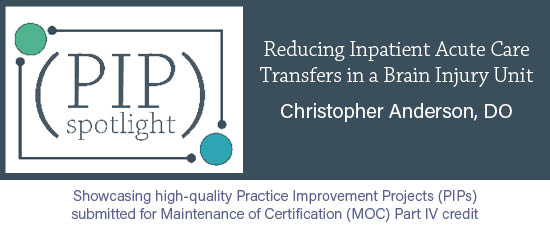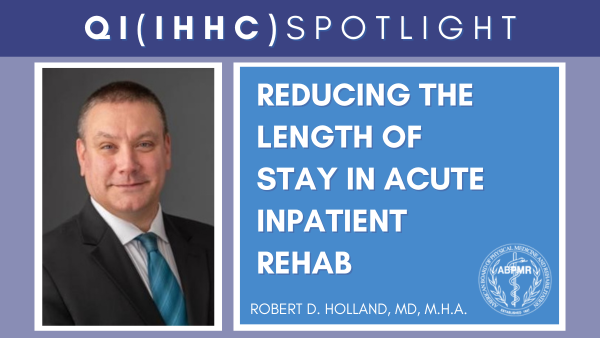CC
PIP Spotlight: Reducing Inpatient Acute Care Transfers in a Brain Injury Unit

The November PIP (Practice Improvement Project) was submitted by Christopher Anderson, DO. Dr. Anderson serves as the physician program director for brain injury rehabilitation at Madonna Rehabilitation Hospital, a free-standing acute inpatient rehabilitation hospital in Omaha, NE.
He participated and led a committee to review a spike in return to acute care discharges from the brain injury unit during the quarter 2 financial year in 2018. The committee implemented changes to decrease those acute care discharges to below the regional weighted benchmark. Dr. Anderson also participated in the subcommittee that met weekly and reviewed all transfers to acute care for the previous year looking for trends, patterns, and causes.
Thank you for sharing your PIP, Dr. Anderson!
The PIP Spotlight is a periodic feature on News Center to highlight exemplary Practice Improvement Projects submitted by your fellow diplomates (or residents) for continuing certification (CC) credit. Diplomates can use the PIP Spotlight as a tool to plan their own PIPs or as a way to connect with other diplomates doing similar work.

What is the problem you are trying to solve?
Acute care transfers from inpatient rehabilitation cause interruption of functional progress and are related to negative overall outcomes. The Acute Rehab Omaha brain injury unit unplanned return to acute transfer rate is higher than desired.
In data from Q2 FY18, there was a 32.6% unplanned return to acute care transfer rate, and only 59% of return to acute care transfers are readmitted back to the Acute Rehab Omaha brain injury unit. Patients have poorer outcomes by both FIM gain and discharge to home rate following acute care transfers. The potential causes of this are the day of the week (especially on weekends), patients not being ready for rehab on transfers within five or less of admission, and medical complications, signs, and symptoms may present differently in the brain injury population.
What data (objective measurements) do you have that supports this as a problem?
- Q2 FY17 - 20.0%
- Q3 FY17 - 18.5%
- Q4 FY17 - 3.8%
- Q1 FY18 - 22.6%
- Q2 FY18 - 32.6%
The weighted regional benchmark for return to acute care is 11.56%
What is your opportunity statement? State the goal you hope to achieve.
Acute Rehab Omaha brain injury unit unplanned return to acute transfers will be less than or equal to 11.56% (the weighted regional average for return to acute care transfers) within six months or two quarters.
What is the underlying cause of the performance/quality problem?
- Weekend transfers to acute
- Medical complications, signs, and symptoms may present differently in the brain injury population
- Brain injury patients not residing on the brain injury unit (peds and LTACH) being transferred to acute
- Patients were not ready for rehab on transfers within five days or less of admission back to acute care
- Patients are sicker on the brain injury unit by case mix index
- Not all patients seen on weekend rounds by the on-call physician
- The on-call physician not as familiar with patients on the brain injury unit

What change(s) did you implement?
A three-person subcommittee was established to meet weekly to review every unplanned transfer to acute care over the previous year to look for patterns/causes
- Days of the week were slightly increased for Saturdays and Sundays transfers compared to the Monday-Friday transfers
Changes implemented: A new sign outpatient list was developed for weekend handoffs to include more medical information and ongoing medical issues to better familiarize on-call physicians with patients
Changes implemented: Residents started performing face-to-face weekend handoffs with on-call physicians on Friday afternoons
Changes implemented: All patients seen on both Saturdays and Sundays for weekend rounds by on-call physicians
- A trend was not identified by unit (brain injury, peds, or LTACH)
- Top two reasons for transfer were infection (29%) and neurologic changes (20%)
- Case mix index was not significantly higher than the national weighted benchmark
Educate staff how medical complications, signs, and symptoms may present differently in the brain injury population with the goal of identifying potential medical changes early to decrease the risk of patients transferring to acute care
Changes implemented: A handout and presentation to nursing, therapy, psychology, dietary, social work, and case management staff was provided concerning, "Medical Complications following TBI"
- 35% of our patients who returned to acute care had a decline in participation with therapies prior to discharge suggesting there is something medically going on with the patient that may need to be addressed
Assuring patients are ready for Acute Rehab prior to admission
- Unplanned transfers back to acute care in less than five days from admission to rehab accounted for 25-33% of all transfers to acute care
Changes implemented: Clinical liaisons updating clinical documents in the shared drive more regularly (daily) with medical changes and therapy notes
Changes implemented: Doctor to doctor phone call prior to accepting admission to insure medical stability and therapy tolerance
Changes implemented: PMR consult completed when possible prior to accepting admission

Did you achieve your goal or target from your opportunity statement? What data do you have to support your conclusion?
Yes, we achieved our goal. After three months, a review of Q3 FY18 was 18% return to acute care, a decrease of 45% from the previous quarter. At six months, a review of Q4 FY18 was 10.4% return to acute care, which is less than the 11.56% weighted regional benchmark goal that was set.

Will you continue with the changes you have implemented?
The committee decided to continue to review all discharges to acute on a quarterly basis looking for trends, patterns, and causes. The weekend sign outpatient list, face to face handoffs on Fridays, weekend rounds on all patients both Saturday and Sunday were continued. Finally, physicians are looking to hire another physician to increase the number of PMR consults done on patients prior to admission to the rehab hospital to help insure medical stability and therapy tolerance.

